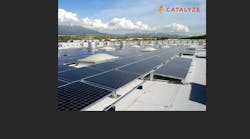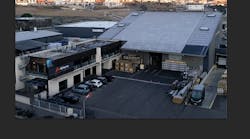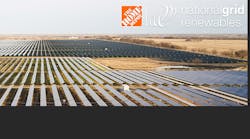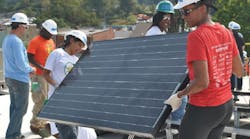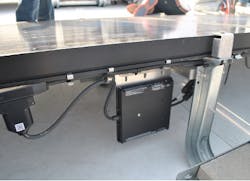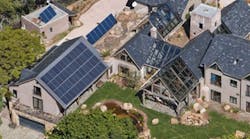The expanding markets for rooftop solar and other forms of distributed, onsite power generation systems may still seem like a far-off, obscure and somewhat unlikely trend in many markets of the United States, but evidence continues to build suggesting there’s a substantial transformation underway in the way your customers’ customers think about electric power.
On a cost basis, rooftop solar – the leading edge of distributed generation – continues to improve its prospects throughout the United States. A study last fall by researchers at Deutsch Bank projected that solar power will reach “grid parity” in all 50 states in 2016. Yes, next year.
Based on a continued decline in costs for the systems and their installation and financing, and assuming that the attempts by utilities to curtail the proliferation of solar are resisted, Deutsche Bank predicted that total residential solar installed will pass 16 gigawatts next year.
The concerns about resistance from utilities may prove only temporary. While some utilities are fighting against net-metering solar systems to let them provide power to the grid, many others are moving through acquisitions and policies to play a role in promoting rooftop solar. We covered the ongoing debates over net-metering last month (EW - Feb. 2015, p. 14, “Money and the Sun”).
Distributed generation and microgrids may have an added beneficial role to play for utilities generally. Former FERC chairman Jon Wellinghoff, in an interview about grid security published on Forbes (go to this article on ewweb.com for links to external sources), pointed to distributed generation and microgrids as the best hope for making the grid more resilient to attacks and natural disasters.
For these and other reasons, we may see the millionth rooftop solar system installed on an American home next year, if not sooner, according to Shayle Kann, senior V.P. of research for Greentech Media. Kann expects to see 250,000 systems installed in 2015, which, added to the 200,000 installed last year and the 145,000 the year before, “will bring the cumulative total number of installations within striking distance of 1 million, and if the market exceeds our expectations, it could foreseeably surpass that mark late this year,” he said.
The advance of rooftop solar depends on cost, and that trend is relentlessly downward. Most of the cost reduction thus far has been from the falling price of photovoltaic modules, but those prices appear to have stabilized. Further reduction in costs that will drive more widespread adoption will come from soft costs and balance of system (BOS) equipment. Thus considerable attention among solar market analysts and advocates is focused on pushing techniques and technologies that further drive down BOS costs and soft costs of solar.
That should spell opportunity for electrical distributors. As the systems become more standardized and commoditized, as the prices and margins compress, they start to look more and more like standard electrical distributor stock goods. Specialty solar distributors and direct-to-installer deals are widespread in the market, but the shift to standardization would seem to favor the distributor with established supplier and customer relationships beyond the discrete solar system.
If solar panels are not proliferating on rooftops in your neighborhood, you have an opportunity to get ahead of the curve and establish yourself as the reliable source of products and expertise. Many traditional electrical manufacturers, familiar names in our part of the industry, are building packages of products for this market, so setting yourself up for solar may be as easy as expanding your relationship with your existing suppliers. You’ll be even better off if you develop relationships with some new companies as well.
Much of the further cost savings in distributed generation systems will be won by saving installers time, so it fits perfectly with the drivers of new product development in the electrical industry generally.
Innovations aimed at reducing labor and installation costs are proliferating in all BOS categories. BOS manufacturers and system installers are doing video timed-motion studies on rooftops throughout the world, looking for any step they can simplify or cut out entirely.
For one example, Andalay Solar recently secured a patent on a design for electrical connectors built into the frame of a photovoltaic panel. “As the modules are assembled, the electrical connections automatically and instantly connect, thereby reducing the amount of rooftop manual labor normally needed to complete wiring for solar systems,” the company said in a release announcing the patent.
This kind of plug-and-play application is the order of the day. Whether it’s microinverters built into solar panels to create a unit that outputs AC power instead of DC or revenue-grade meters built into inverters such as a new introduction from SolarEdge, technology development to simplify system design and installation is where the cutting edge is now.
Here’s a look at key components of the balance-of-system package.
Other than the photovoltaic panels themselves, the inverter is the core of a solar power system. It converts the DC power generated in the panels to AC that can provide power to the electrical system in the home or business. Advanced inverters are a key component of many utilities’ plans for integrating solar distributed generation into their grids. Advanced inverters have built-in communications and intelligence capabilities to allow the utility to shift loads and adapt their system to the two-way flow of power.
Microinverters and other power electronics are increasingly integrated with the photovoltaic panels and the package is shipped AC-ready. Microinverters are taking over the market, particularly in the United States and Japan. That may reduce the line-item opportunity for distributors, as microinverters are often shipped as an OEM part integrated into AC-ready solar panels and making them AC-ready simplifies the wiring.
Combiner boxes and overcurrent protection. This is where the DC power from a string of panels is brought together to simplify the run to the inverter. Combiner boxes often include DC overcurrent protection devices such as fuses and circuit breakers to protect the inverter. There’s also a special class of fireman switches designed to allow firefighters to shut down a rooftop system when fighting a fire to avoid electrocution.
Wire and cable. Specialized wiring for solar panels is designed for enhanced resistance to the sun’s rays and for efficient conducting of DC power. Fine-strand, UL-listed, NEC RHW, THW or THHW are the standard types used for battery and inverter cabling.
Connectors. Although it’s possible the market will turn the direction of Andalay Solar and integrate electrical connections into the photovoltaic panels, the more widespread solution is a set of standardized connectors called MC4. This is a locking male-female connector type specific to solar applications.
Mounting and racking. New designs are constantly being introduced to make the racking simpler, lighter, more solid and less hazardous to the integrity of the roof. Some panel makers have been working on ways to integrate the racking into the frame of the panels. Unirac is the leader in this category. Traditional electrical companies involved here include Eaton/Cooper’s B-Line brand.
Power conditioning equipment. Many electrical industry stalwarts are active in this space. An article on Solar Professional magazine’s SolarPro website suggests that a single-vendor approach is best, which should benefit electrical distributors. “In most cases, it is advantageous to specify power-conditioning equipment that includes inverters, PV charge controllers (if used) and integration hardware from a single manufacturer. This strategy enables full networking integration between components and streamlines system design and installation.”
Metering. Revenue-grade metering will be necessary for customers who want to tie into the grid and participate in net-metering programs. The meters can also support reporting for access to state and federal rebates, as well as performance-based incentives (PBIs) and solar renewable energy certificates (SRECs).
Monitoring. This is one of the more fluid product categories in solar right now, as technology companies look for ways to empower homeowners with data on how their system is working. Look for systems such as Google’s Nest HVAC controls and other smart home systems to increasingly feature ways to handle the data produced by the home’s power system. Electrical manufacturers are very active in this space.
Those are the main components of rooftop solar’s balance of system package. Cost reductions across these categories and in the “soft costs” of labor, permitting, inspections, regulatory compliance, and perhaps most of all financing will be pivotal factors in how quickly solar distributed generation rolls out from market to market.
If you work in a market where rooftop solar is still a rarity, and there still are many of those, you have the chance to set your company up as a local early adopter and pioneer this market. Talk to your existing suppliers, if they haven’t opened the conversation yet. Get familiar with what they have in the catalog or in development that’s specialized for the solar market.
If the distributed solar revolution has already begun in your markets, you may still find a valuable and lucrative role to play in providing the balance of system equipment to your existing commercial and residential customers.


